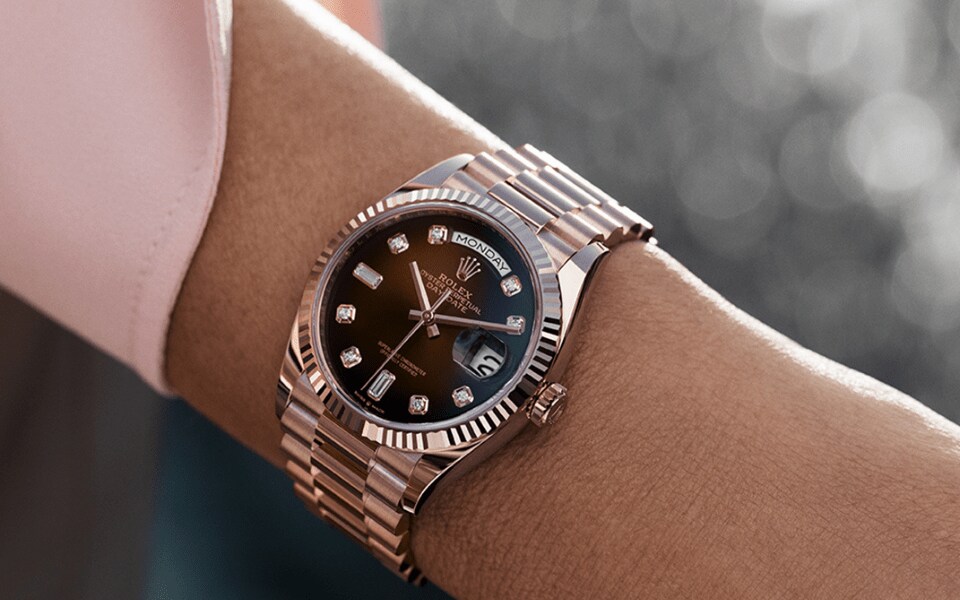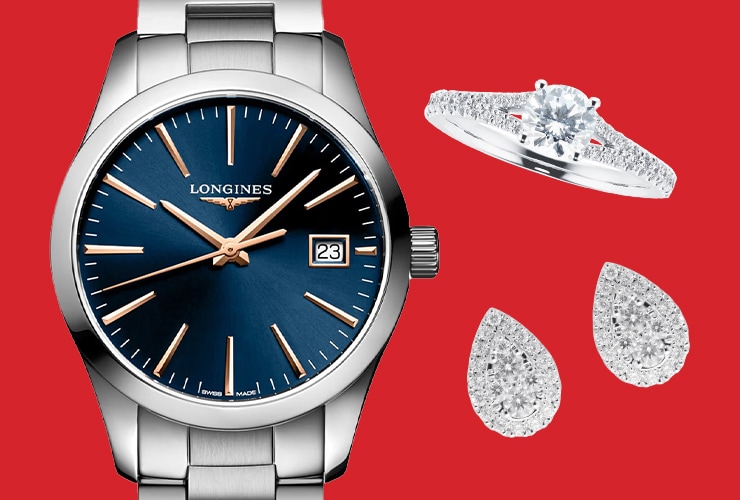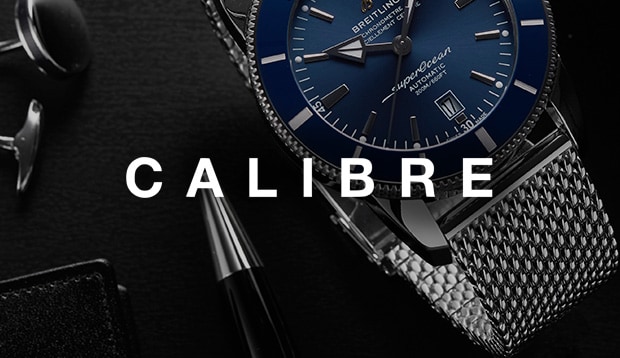-
SALE
Sale JewellerySale WatchesBy Price
-
Diamonds
By Category
-
Engagement
By Category
-
Weddings
Featured
- Jewellery
By CategoryBy Metal TypeBy GemstoneBy BrandBy Edit- Watches
By CategoryBy CollectionBy Luxury BrandBy Designer Brand- Rolex
FeaturedBy Collection- Rolex Certified Pre-Owned
- Brands
FeaturedBrands A-Z- Gifts
By CategoryBy PriceBy Popular Brand- Pre-Owned
By CategoryBy Brand- Sell Your Watch
Sell your watchWe will expertly assess your watch and offer you
a competitive and accurate valuation for the
watch you wish to sell to us.Free Instant Valuation
Drop off at any Showroom
Unrivalled Knowledge & Expertise- Editorial
- Jewellery
- Shop by Category
- SALE
- Diamonds
- Engagement Rings
- Weddings
-
Jewellery
- Back
- Jewellery Offers
- Shop All Jewellery
- Jewellery Home
- By Category
- By Metal Type
- By Gemstone
-
By Brand
- 886 by The Royal Mint
- Amor
- Bijoux Birks
- BOSS
- Calvin Klein
- Chopard
- Emporio Armani
- Fabergé
- FOPE
- FRED
- Georg Jensen
- Goldsmiths
- Gucci
- Jenny Packham
- Kiki McDonough
- Lauren By Ralph Lauren
- Mappin & Webb
- Marco Bicego
- MARIA TASH
- Messika
- Michael Kors
- Olivia Burton
- Pasquale Bruni
- Pomellato
- Repossi
- Roberto Coin
- Skagen
- Susan Caplan
- SUZANNE KALAN
- SWAROVSKI
- Ted Baker
- THOMAS SABO
- Tommy Hilfiger
- By Edit
-
Watches
- Back
- Watch Offers
- Shop All Watches
- Watches Home
- By Category
- By Collection
-
By Luxury Brand
- Rolex
- Rolex Certified Pre-Owned
- BALL
- Bamford
- Baume & Mercier
- Bell & Ross
- Blancpain
- Breitling
- Bremont
- Cartier
- CHANEL
- Chopard
- DOXA
- Frederique Constant
- Girard-Perregaux
- Glashütte Original
- Grand Seiko
- Gucci
- Hublot
- ID Genève
- IWC Schaffhausen
- Jaeger-LeCoultre
- Junghans
- Keris
- Longines
- MeisterSinger
- Montblanc
- Nivada Grenchen
- NOMOS Glashütte
- NORQAIN
- OMEGA
- Oris
- Panerai
- Piaget
- Rado
- RAYMOND WEIL
- TAG Heuer
- TUDOR
- Ulysse Nardin
- ZENITH
- By Designer Brand
- Rolex
- Rolex Certified Pre-Owned
-
Brands
- Back
- View All Brands
-
A-Z
- Rolex Watches
- Rolex Certified Pre-Owned
- 886 by The Royal Mint
- Accurist
- Amor
- Arnold & Son
- BALL
- Bamford
- Baume & Mercier
- Bell & Ross
- Blancpain
- Bijoux Birks
- BOSS
- Breitling
- Bremont
- BVLGARI
- Casio
- Calvin Klein
- Cartier
- Certina
- CHANEL
- Chopard
- Citizen
- Czapek
- DOXA
- Emporio Armani
- Encelade 1789
- Fabergé
- FOPE
- FRED
- Frederique Constant
- Garmin
- Georg Jensen
- Gerald Charles
- Girard-Perregaux
- Glashütte Original
- Goldsmiths
- Grand Seiko
- G-SHOCK
- Gucci
- Hamilton
- Hublot
- ID Genève
- IKEPOD
- IWC Schaffhausen
- Jacob & Co
- Jaeger-LeCoultre
- Jenny Packham
- Keris
- Kiki McDonough
- G-SHOCK
- Lauren By Ralph Lauren
- Longines
- Louis Erard
- Mappin & Webb
- Marco Bicego
- MARIA TASH
- Maurice Lacroix
- Michael Kors
- Messika
- Montblanc
- Nivada Grenchen
- NOMOS Glashütte
- NORQAIN
- Olivia Burton
- OMEGA
- Oris
- Panerai
- Parmigiani Fleurier
- Pasquale Bruni
- Piaget
- Pomellato
- QLOCKTWO
- Rado
- RAYMOND WEIL
- Repossi
- Roberto Coin
- Rolex
- Rolex Certified Pre-Owned
- Seiko
- Skagen
- Susan Caplan
- SUZANNE KALAN
- SWAROVSKI
- TAG Heuer
- Ted Baker
- THOMAS SABO
- Tissot
- Tommy Hilfiger
- TUDOR
- Ulysse Nardin
- Vivienne Westwood
- William Wood Watches
- WOLF
- ZENITH
- Gifts
-
Pre-Owned
- Back
- Shop Pre-Owned Watch Sale
- Shop All Pre-Owned
- Pre-Owned Home
- By Category
-
By Brand
- Rolex Certified Pre-Owned
- Pre-Owned Patek Philippe
- Pre-Owned TAG Heuer
- Pre-Owned Cartier
- Pre-Owned Jaeger-LeCoultre
- Pre-Owned Breitling
- Pre-Owned OMEGA
- Pre-Owned Longines
- Pre-Owned Tudor
- Pre-Owned IWC
- Pre-Owned Panerai
- Pre-Owned Blancpain
- Pre-Owned Breguet
- Pre-Owned Chopard
- Pre-Owned Rado
- Pre-Owned Vacheron Constantin
- Pre-Owned Zenith
- Sell Your Watch
- Editorial
- My Account
- Wishlist
- Store Finder
- Book an Appointment
- Help & Support
A Guide To Luxury Watch Materials
By Watches of Switzerland Group | 8 minute read

When it comes to creating a luxury timepiece, there is an incredible range of materials available, each with their own benefit, cost consideration, and aesthetic charm. The choice of material also influences how a watch will feel on your wrist, as well as form, function, and it can even determine the longevity of the timepiece. All in all, this is an important aspect to consider when looking for your next luxury watch.
It’s often agreed that precious metals are the hallmark of haute horology. However, using traditional materials, such as gold and platinum, hasn’t stopped leading luxury brands in pushing the boundaries of science in this area as well; taking inspiration from both technology and aerospace.
With so much choice – and so much to consider – we’ve created a comprehensive guide to luxury watch materials. Because no matter the advantages, really the choice comes down to personal preference. Here you’ll be able to find the best option for you.
Gold
Gold is pretty unassailable in the world of luxury watches. It’s a quintessential marker of quality and is still the material of choice for many of the world’s finest timepieces. Using it to its full potential has been a lifelong obsession for some of the most gifted watch designers.
Gold is used to make a variety of watch elements and the most delicate parts of the movement.
In its purest form, this precious metal would be too malleable. So other metals such as silver, copper, and palladium are combined with it to give it the necessary hardness and mechanical resistance. The alloy that’s created is more robust and resistant to tarnishes.
Its fineness is expressed in carats, which represents the percentage of gold versus other base metals. Although 24-carat is the purest, many luxury watches use 18-carat gold. This means that 75% is pure gold, with the remaining 25% being other metals.These alloys also mean the colour of the gold can be varied by adjusting the proportions of copper and silver in the 25% that isn’t of gold.
These are the three main colours:
Yellow Gold
To create the beautiful colour of yellow gold, pure gold is alloyed with silver, copper, and sometimes zinc. This combination gives a rich, lustrous gleam. The result is a timeless look that will never go out of style.
It is most often associated with the classic gold watch, especially when it comes to dress watches.
White Gold
White gold is accomplished by combining pure gold with nickel, copper, zinc, and palladium. Sometimes rhodium is used to create the alloy. The result is understated elegance. It’s a popular choice because the look is more discreet than watches made from yellow gold.
At a glance, white gold can look a lot like stainless steel. The giveaway is its weight as white gold is heavier. It also scratches more easily than steel, so higher-end white gold is often reserved for dressier timepieces.
Rose Gold
Rose gold has surged in popularity and is fashionable in modern watches. To make it, pure gold is alloyed with copper and silver. The more copper that’s added, the darker the hue. A small percentage of silver or zinc can also be added for the desired tone.
Rose gold is often considered a contemporary version of the classic yellow gold watch. The rose tone helps to give it a more modern look while keeping a touch of luxury. Some consider it to be more elegant or feminine, but rose gold is increasingly used in men’s watches to soften the masculine aesthetic. Some brands increase the copper content to create a more intense ‘red gold’, such as in the OMEGA Constellation Co-Axial and Rolex Everose.
As well as its inherent radiance, gold in its purest form is tarnish- and corrosion-resistant, not to mention durable, and lends itself especially well to dress watches.
Stainless Steel
Stainless steel is the most commonly used material for watches, largely due to its balance of being durable yet lightweight. The metal is an alloy of iron mixed with carbon, chromium and nickel, making it resistant to scratches and corrosion.
Stainless steel watches come in two types of finish. They can have a brushed look to appear more rugged, or polished to give extra shine.
It also has a few interesting properties. The small inclusion of nickel makes it hypoallergenic, which reduces skin irritation that can be created by moisture or sweat. Also, the addition of chromium makes it resistant to rust.
First used in wristwatches back in the 1930s, stainless steel remains popular today. The quality does vary and different grades of steel are used by watchmakers, but generally steel graded as 316L is the industry benchmark for luxury timepieces.
Titanium
Titanium is a grey metal that’s lightweight and even more durable than steel. It tends to be alloyed with other materials such as aluminum, nickel, palladium. Titanium made its timepiece debut in the 1970s and has become a staple material for diving watches.
This non-magnetic metal is also hypoallergenic, making it a great choice for sports watches and for people that suffer from metal allergies or skin irritation. It comes in 28 grades, with 1-4 being the purest titanium.
You’ll struggle to find a tougher material in the watchmaking world. Titanium watches can be made with grade 5 titanium, which is fives times stronger than steel but only half the weight. For that it’s often used for larger timepieces that might otherwise be too heavy on the wrist.
Although known for its impressive strength-to-weight ratio, the leading luxury brands have been able to combine its utility with a refined aesthetic. Titanium watches meet two niches: their durability makes them great for diving and sports. They also fill a gap between the entry-level steel models and timepieces with precious metal components.
Ceramic
High-tech ceramic is made from zirconium oxide – a hardened form of clay. As a material, it’s neither a metal nor a polymer. It’s created through a process of heating and cooling and is extremely durable. It’s also lighter than steel or titanium.
Ceramic has an ornate, highly polished look and a luxurious texture. Yet it also scores well on durability – so high are its levels of heat-resistance that NASA used it for the shields of the Space Shuttle.
Watch fans love the fact that ceramic-based watches are relatively easy to clean. While it was once only available in black, white or silver, it’s now possible to create the ceramic in a range of colours. A recent breakthrough came in 2017, when Audemars Piguet debuted an all-black, all-ceramic version of the Royal Oak Perpetual Calendar.
Hublot is just one of the other leading brands to embrace the full potential of the material, as seen in its blue Spirit Of The Big Bang with micro-blasted black ceramic case and bezel.
Carbon Fibre
Carbon Fibre is composed of carbon atoms bonded together to form a long chain. It’s one of the most high-tech and advanced materials used by watchmakers today. It’s also one of the most varied, with each brand having their own signature variety.
On the one hand, luxury timepieces are about the timeless aesthetic. On the other, they are pieces of precision engineering, relying on technology and innovation. So the leading luxury brands are looking to new materials. Given that carbon fibre is used by leading sports brands, there’s also a link with health and fitness.
Taking their lead from the automotive and aerospace industries, Audemars Piguet and TAG Heuer are two of the brands to have embraced ultra-lightweight, ultra-robust carbon fibre as a material.
Diamond-Like Carbon
Many watch enthusiasts love the dramatic results of a diamond-like carbon (DLC) coating. This is applied by a process called Physical Vapor Deposition (PVD), in which the coating is fired onto the surface of the watch and then immediately cooled. DLC is impervious to wear and tear, so your timepiece will never be without its glossy sheen.
Carbotech, a reinforced version of carbon fibre, is a key feature of Panerai’s utility-led designs – and Panerai is certainly not the only manufacturer to be working with cutting-edge proprietary materials.
Many watch houses have poured years of research into perfecting their own bespoke solutions. From Oystersteel to Cerachrom to Rolesium, Rolex has been meticulous in the way it has developed and then constantly re-evaluated its own inventory of materials.
Platinum
Platinum is a precious metal that’s 30 times rarer than gold. It’s usually 95% pure and naturally white, so it won’t fade or tarnish. It’s the most prestigious of the precious metals and is mainly used for cases on high-end luxury timepieces.
The density of platinum gives it incredible durability. It’s also hypoallergenic so ideal for those with sensitive skin. As opposed to white gold, which is generally rhodium-plated to give it its bright silver color, platinum is naturally silver and lustrous.
Although expensive, it has a rare property that makes it popular for luxury watches. When platinum scratches, none of the volume is lost. The metal is simply displaced and ridges are raised on the edge of the scratch. It develops a patina over time that can be regularly polished because it is simply moving the metal around, not wearing it down.
Bronze
Though its use as a watch material is still comparatively rare, bronze has certainly caused a stir in the market over the past few years.
At least some of this is down to the Tudor Black Bay Bronze, which has attracted a lot of attention and admiration. The timepiece is created entirely in bronze, aside from a steel case back coated in bronze-coloured PVD. The design is redolent of vintage nautical instruments and diving equipment. Following its success, the Black Bay Bronze was also released, boasting a chic slate-grey dial.
Bronze is a mix of copper and tin, with other materials often added for good measure. It’s by no means a new material, but is very much in fashion. Customarily seen in maritime settings, bronze makes for an apt metal in dive watches.
The key selling point of bronze is its appearance, and the way it changes over time. Contact with air causes the outer layer to oxidise, producing a patina that over time will give your watch a completely unique look. Only the surface is affected, with the underlying metal left protected from corrosion.
Sign Up For Calibre Newsletter
Get a round up of the latest stories from Calibre every month, directly to your inbox.
© 2025 Goldsmiths
Goldsmiths is a trading name of Watches of Switzerland Company Limited. Registered Office: Aurum House, 2 Elland Road, Braunstone, Leicester, LE3 1TT, Registered in England and Wales, Company number 00146087. Registered VAT Number 834 8634 04. Watches of Switzerland Company Limited acts as a broker and not a lender and offers finance from Secure Trust Bank PLC trading as V12 Retail Finance and PayPal UK Ltd, 5 Fleet Place, London, United Kingdom, EC4M 7RD trading as PayPal Credit. Watches of Switzerland Company Limited is authorised and regulated by the Finance Conduct Authority. Our registration number is 308710. *Credit is provided subject to affordability, age and status. Minimum spend applies. Terms and Conditions apply. UK residents only. Not all products are regulated by the Financial Conduct Authority and FOS protection will not be extended to unregulated agreements. Please note the Consumer Credit Act states that should your purchase / loan amount cost more than £30,000 you will not be covered under Section 75 of the Consumer Credit Act.
*Next day delivery available on most items. See product pages for more information.









